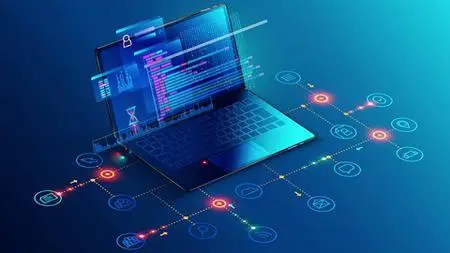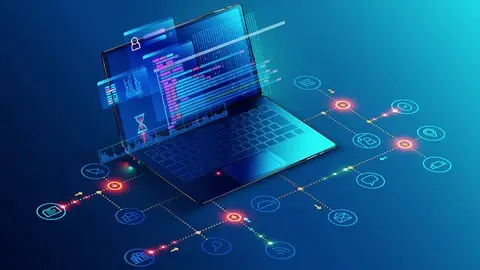Java: Enterprise App Development With Java 9: 4-In-1
Last updated 7/2018
MP4 | Video: h264, 1280x720 | Audio: AAC, 44.1 KHz
Language: English | Size: 3.07 GB | Duration: 8h 52m
Last updated 7/2018
MP4 | Video: h264, 1280x720 | Audio: AAC, 44.1 KHz
Language: English | Size: 3.07 GB | Duration: 8h 52m
Build modern and scalable enterprise applications using Java 9 and Java EE 8 to become a professional Java developer!
What you'll learn
Create efficient lock-free programs that leverage the multi-core architecture of the CPU using Java 9’s features
Gain practical experience of Java 9, including modules, the Streams API, the Collections API, multi-level JARs and HTTP/2 clients.
Build real enterprise Java applications including a website and a microservice
Building APIs for the connected web
Build a simple music streaming service
Learn about enterprise Java (JEE 8), including JSF, JPA, and CDI
Use the Reactive programming model to create efficient programs
Requirements
Prior programming experience of Java is assumed.
Description
A lot of applications built today need to handle huge amounts of traffic in low latency. Java is a very popular language and JVM is a popular platform to build high performance programs in Java. Writing high-performance concurrent and thread-safe programs is hard, but you’ll discover how and see what Java 9 adds to the software engineer toolkit.Java 9 comes with a rich feature set. It intends to change the way Java developers used to write code. It introduces a modular JDK so that developers can only include the modules that they need. The prospect of being one of the first to explore the brand new JDK from Java is the primary motivator. Also, this is the biggest change been introduced in Java for a while.This comprehensive 4-in-1 course will set you on the path to become a skilled and professional Java developer by exploring Java 9 and Java EE 8 and learning how these technologies can be used to create a modern, scalable enterprise application. Comprehensive and detailed, the easy to follow tutorial will take viewers on a journey to going from zero to hero Java programmers with the new Java 9 SDK.Contents and OverviewThis training program includes 4 complete courses, carefully chosen to give you the most comprehensive training possible.The first course, Java 9 Core Principles, covers exciting real-world examples with Java. As you progress in your journey, you will encounter more advanced topics including functional data processing, before investigating how you can build fast, scalable APIs for the connected web. In the final section, you will build an API to analyze the sentiment of sentences provided by the user, along with various statistics about your API.The second course, Java 9 New Features Deep Dive, covers new modular programming concept in Java 9 and know how it will affect you and your clients ahead of time.We will start up with the setting up of Java 9 and learn the modularization concepts and then proceed to deployment. This should be hands on look at Java 9, but no one will be using it to make real-world applications yet. This is an assessment video for the millions of Java developers out there looking to put it to the test.The third course, Writing High Performance Java Application in Java 9, covers how to monitor applications and write code in high concurrent with the proper tools. First, we’ll create efficient lock-free programs that leverage the multi-core architecture of the CPU using the newest Java 9 features. Then you’ll see how Java Memory Model affects the performance of your programs. You’ll discover why it’s even more important to be aware of the software-hardware co-operation of your programs in Java 9. Moving on, you’ll find out how to leverage constructs from JAVA 9 java.util.concurrent to create efficient multi-threaded programs. We’ll explore the different kinds of locking available in JAVA 9 and get to know when you should use which kind of locks. Finally, you’ll see what tools are shipped with the JDK 9 and know how to use them properly.The fourth course, Hands-On Enterprise Application Development with Java 9, covers modern and scalable enterprise applications using Java 9 and Java EE 8 and become a professional Java developer. We will use case studies to explore how we can use the JEE8 technologies of JSF, EJB, and JPA to build a database-driven website, while all the time working with new Java 9 constructs. You'll learn how to extract a component from our website as a standalone microservice and decouple your microservice to allow it to be reused within an organization. We will then delve into Java 9 technologies such as JShell, modules, the Streams API, Multi-Jar, Process APIs, and HTTP/2 clients.By the end of the course, you’ll get up and running with Java with exciting real-world examples to monitor applications and write code in high concurrent with the proper tools leveraging Java Concurrency.About the AuthorsColibri is a technology consultancy company founded in 2015 by James Cross and Ingrid Funie. The company works to help its clients navigate the rapidly changing and complex world of emerging technologies, with deep expertise in areas such as big data, data science, machine learning, and cloud computing. Over the past few years they have worked with some of the World's largest and most prestigious companies, including a tier-1 investment bank, a leading management consultancy group, and one of the world's most popular soft drinks companies, helping all of them make better sense of their data and process it in more intelligent ways. The company lives by its motto: Data -> Intelligence -> Action. Andrei Ruse, our Author, is currently working with Colibri Ltd, has been working as a software developer in the financial service industry for over 3 years, and has over 6 years' experience with Java as the main programming language, both academically and professionally. Prior to his current role in a FinTech startup in London, he spent three years working for one of the World's largest investment banks, having joined it straight after graduating from Manchester University with a degree in Computer Science.
Peter Verhas is a senior developer and software system architect with more than 30 years' software development experience. He currently works for EPAM as a senior developer, where he is involved in many customer projects and actively participates in the educational activities of the company. Peter writes a technical blog and is committed to open source software development. He has been using Java since 2005 and is also an author at Java Code Geeks.
Tomasz Lelek is a Software Engineer who programs mostly in Java and Scala. He is a fan of microservice architectures and functional programming. He dedicates considerable time and effort to be better every day. Recently, he's been delving into big data technologies such as Apache Spark and Hadoop. He is passionate about nearly everything associated with software development. Tomasz thinks that we should always try to consider different solutions and approaches to solving a problem. Recently, he was a speaker at several conferences in Poland - Confitura and JDD (Java Developer's Day) and also at Krakow Scala User Group. He also conducted a live coding session at Geecon Conference. He is currently working on this website using MLMartin Farrell is an independent Java consultant and trainer based in Edinburgh, UK, with over 18 years' Java experience. He has consulted across a range of businesses from banking to telecommunications and Silicon Valley start-ups. He also blogs about Java and Spring technologies on the popular javabullets blog, and is Most Valuable Blogger at dzone and a contributor to When not consulting, Martin likes to spend time with his wife and two children. He is also a keen cyclist and triathlete.
Overview
Section 1: Java 9 Core Principles
Lecture 1 The Course Overview
Lecture 2 Installation and Setup
Lecture 3 Introduction to the Java Programming Language and Its History
Lecture 4 Introduction to the JVM
Lecture 5 Java 101 – "Hello World” Example in JShell"
Lecture 6 Introduction to OOP
Lecture 7 Introduction to OOP Principles
Lecture 8 Introduction to the Application
Lecture 9 The Foundations – Creating Classes for Songs, Artists, Albums, and Listeners
Lecture 10 Abstract Classes and Interfaces
Lecture 11 Untyped Versus Typed Data Structures
Lecture 12 Maps and Sets
Lecture 13 Linking All of Our Models together
Lecture 14 Creating Static Methods
Lecture 15 Creating Instance Methods
Lecture 16 Loading Our Streaming Service with Data
Lecture 17 Creating an Interactive Shell for Our Application and Testing
Section 2: Java 9 New Features Deep Dive
Lecture 18 The Course Overview
Lecture 19 Working with Modules
Lecture 20 Limiting Access to APIs
Lecture 21 Handling the Migration to Java 9
Lecture 22 Using JShell
Lecture 23 Other New Features of Java 9
Lecture 24 Java 9 Tooling Support
Lecture 25 Java 9 Garbage Collection
Lecture 26 Java 9 Logging
Lecture 27 Other Features and Enhancement
Section 3: Writing High Performance Java application in Java 9
Lecture 28 The Course Overview
Lecture 29 Java Memory Model
Lecture 30 Hardware Affinity
Lecture 31 JVM Intrinsic Functions
Lecture 32 Understanding and Analyzing Bytecode
Lecture 33 Optimistic Locking Versus Pessimistic Locking
Lecture 34 CompareAndSet Structures
Lecture 35 Coordinating Threads
Lecture 36 Java 9 - Reactive Streams
Lecture 37 Detecting Memory Leaks - JVisualVM
Lecture 38 Examining CPU and Resources Usage
Lecture 39 Summary of Writing High Performance Java Applications
Section 4: Hands-On Enterprise Application Development with Java 9
Lecture 40 The Course Overview
Lecture 41 Installing Java 9
Lecture 42 Installing Eclipse
Lecture 43 Installing Open Liberty
Lecture 44 Installing Apache Derby
Lecture 45 Exploring Our Marathon Entry System and Use Cases
Lecture 46 Introduction to JSF
Lecture 47 Displaying Data with JSF
Lecture 48 Inputting Data with JSF
Lecture 49 HTTP/2 Server Push
Lecture 50 What Is CDI?
Lecture 51 Developing Our Payment Service Using CDI
Lecture 52 Using Default Methods on Our Payment Service
Lecture 53 Data Access in Java
Lecture 54 Configuring Data Access in Open Liberty
Lecture 55 Introduction to JPA Mapping
Lecture 56 JPA – Mapping Relationships
Lecture 57 What Is a Microservice?
Lecture 58 Developing a Healthcheck Microservice
Lecture 59 Developing a Payment Microservice
Lecture 60 Introduction to Java Modules
Lecture 61 Java 9 Modules Examples
Lecture 62 Java 9 Multi-Release Jars
Developers looking to get started with programming in Java, or looking to learn what’s new to the language in Java 9.,Software engineers with professional experience in Java who want to create very efficient and high-performance applications in Java 9.,Programmers who want to take their knowledge of Java to the next level by learning to build enterprise-level applications using Java 9 and its new features.



